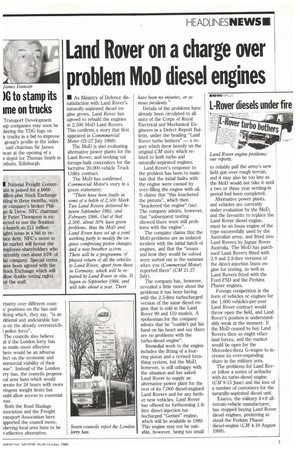Land Rover on a charge over problem MoD diesel engines
Page 3

If you've noticed an error in this article please click here to report it so we can fix it.
• As Ministry of Defence dissatisfaction with Land Rover's naturally-aspirated diesel engine grows, Land Rover has agreed to rebuild the engines in 2,500 MoD Land Rovers. This confirms a story that first appeared in Commercial Motor (21-27 July 1988).
The MoD is also evaluating alternative power plants for the Land Rover, and seeking out foreign-built contenders for the lucrative 20,000-vehicle Truck Utility contract.
The MoD has confirmed Commercial Motor's story in a press statement: "There have been faults in some of a batch of 2,500 Mark Two Land Rovers delivered between September 1985, and February 1986. Out of that 2,500, about 30% have given problems, thus the MoD and Land Rover have set up a joint working party to modify the engines comprising piston changes, and a new breather system. . . There will be a programme of phased return of all the vehicles to Land Rover, apart from those in Germany, which will be repaired by Land Rover in situ. It began in September 1988, and will take about a year. There
have been no injuries, or serious incidents."
Details of the problems have already been circulated to all units of the Corps of Royal Electrical and Mechanical Engineers in a Defect Report Bulletin, under the heading "Land Rover turbo bothers" — a report which drew heavily on the original CM story which related to both turbo and naturally-aspirated engines.
Land Rover's response to the problem has been to maintain that the initial faults with the engine were caused by over-filling the engine with oil. It claims that "this knackered the pistons", which then "knackered the engine" (sic). The company admits, however, that "subsequent testing showed there were still problems with the engine".
The company claims that the MoD problems are an isolated incident with the initial batch of engines, and that the "issues and how they would be solved were sorted out in the summer when you (Commercial Motor) reported them" (CM 21-27 July).
The company has, however, revealed a little more about the problems it has been having with the 2.5-litre turbocharged version of the same diesel engine that is sold in the Land Rover 90 and 110 models. A spokesman for the company admits that he "couldn't put his hand on his heart and say there are no problems with the turbo-diesel engine".
Remedial work to the engine includes the fitting of a fourring piston and a revised breathing system, but the MoD, however, is still unhappy with the situation and has asked Land Rover to supply an alternative power plant for the rest of its 7,000 diesel-engined Land Rovers and for any further new vehicles. Land Rover has offered its forthcoming 1.8litre direct-injection turbocharged "Gemini" engine, which will be available in 1989. This engine may not be suitable, however, being too small to reliably pull the army's new field gun over rough terrain, and it may also be too late as the MoD would not take it until a two or three year settling-in period had been completed.
Alternative power plants, and vehicles are currently under evaluation by the MoD, and the favourite to replace the Land Rover diesel engine, must be an Isuzu engine of the type successfully used by the Australian army, and fitted into Land Rovers by Jaguar Rover Australia. The MoD has purchased Land Rovers fitted with 3.9 and 2.8-litre versions of the direct-injection Isuzu engine for testing, as well as Land Rovers fitted with the Ford FSD and the Perkins Phaser engines, Foreign competition in the form of vehicles or engines for the 1,600 vehicles-per-year Land Rover contract would throw open the field, and Land Rover's position is understandably weak at the moment. If the MoD ceased to buy Land Rovers then so might other land forces, and the market would be open for the Mercedes-Benz G-wagen to increase its ever-expanding share in the military area.
The problems for Land Rover follow a series of setbacks with its turbo-diesel engine (CM 9-15 June) and the loss of a number of customers for the naturally-aspirated diesel unit.
Esarco, the military 8x8 allterrain-vehicle manufacturer, has stopped buying Land Rover diesel engines, preferring instead the Perkins Phaser diesel-engine (CM 4-10 August 1988).






























































